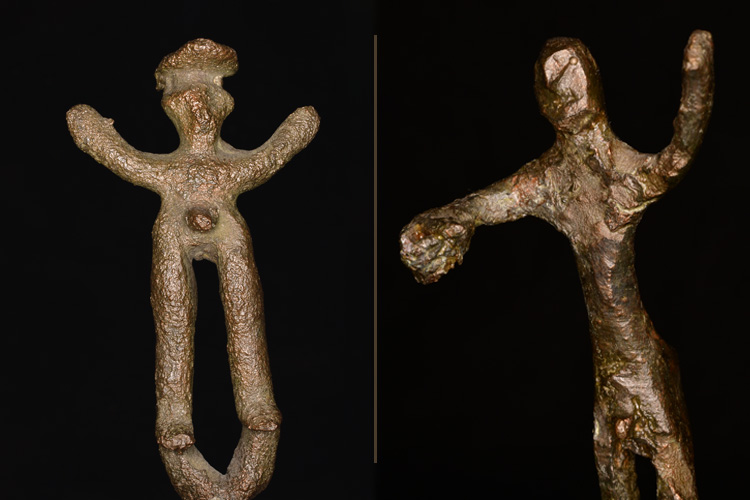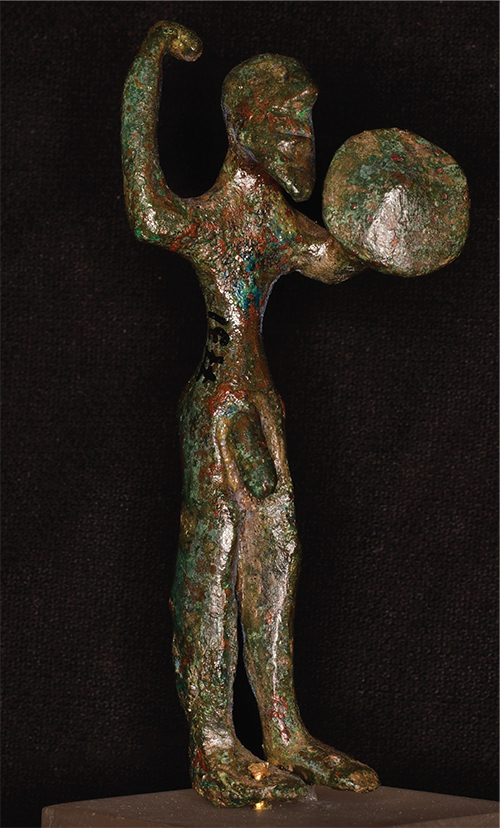For ancient Greek men taking part in athletics, nudity was their spandex.
For over a thousand years of Greek antiquity (ca. 1100 BCE–500 CE), athletes skilled in running, long jump, discus, javelin and other events trained and competed in the buff. They represented the ideal male body type and were regarded as citizens of a high socioeconomic status.
But why? What was so important about nudity that turned it into the respected standard for athletic endeavours?
Sarah Murray, an assistant professor with the Faculty of Arts & Science’s Department of Classics, seeks to uncover this mystery in her new book, Male Nudity in the Greek Iron Age.
“One of the things I love about the ancient Greeks is that a lot of the things they do are really weird,” she says.
“How did it come about that the Greeks uniquely amongst ancient Mediterranean societies, developed both an aesthetic ideal of the nude male as well as a unique set of social practices that involved regular nude public exercise?” asks Murray.
“This question always struck me as really interesting, because we have so much in common with the Greeks, especially our fascination with athletics and sports.”

According to Murray, there’s been plenty of research and discussion among historians and academics about nudity within ancient Greek society. “But the question of how the nude male become so central in Greek art and in Greek culture had never really been resolved.”
A lack of historic materials makes finding the answer especially challenging.
“The Greeks themselves don't say anything about it,” says Murray. “We have tons of texts from the classical Greek world, but nobody comes out and says, ‘Here's why we think it's important for males to work out nude together.’”
There are a number of theories that might explain this. One possibility: nudity creates bonding within a group.
If you have a group of males, and they have to learn to work together, doing something like getting naked in a gymnasium on a regular basis can be a powerful tool for creating a group bond.
“If you have a group of males, and they have to learn to work together, doing something like getting naked in a gymnasium on a regular basis can be a powerful tool for creating a group bond,” says Murray.
Another theory is that the athletes’ full body tans and fit physiques represented health and wealth — a sign of having the luxury to spend much of their time training and strengthening their bodies. “If you're a farmer who tried to work out naked you would immediately stand out as not a member of this class because you would not have the ideal full-body tan,” she says. “The ancient Greeks even had a derogatory word, leukopygos or ‘white-rumped’, which connoted cowardly, unmanly men who did not have the right tan.”
Though texts do not shed much light on the origins of Greeks’ fascination with the nude male, Murray believes some answers can be found through studying small bronze figurines that date from the final phase of the Bronze Age (1200–1050 BCE) and the first phases of the Iron Age (1050–700 BCE).

The figurines are just a few inches high and quite basic in design.
“They're very abstract and the manufacturing is rather rough,” says Murray, who spent countless hours in Greek museums studying them. “They're cast in bronze. But they're not cast very well. A lot of them still retain pieces of the casting apparatus, which suggests either that the smiths who made them either didn't care to refine the final appearance or did not have the skill to do so. They look like the kind of thing a kid would make with playdough.”
Because of their small size and lack of visual appeal, historians often dismiss them as insignificant. But Murray believes they may have played an important role in a ceremony that involves the transition from boyhood to manhood, and later formed the foundation of practices involving Greek male nudity.
“Since these figurines are the first visual depictions of nude males in Greek art, it seemed important that someone at least make a serious inquiry on how they might fit into the picture,” she says.
The very first figurines were made on the island of Crete, which is also the site of later texts that mention important initiation ceremonies that young men in the community underwent, in order to move from youth to adulthood.
“I propose that the production of figurines was a kind of transformation that was symbolically powerful,” she says, referring to the figurines’ transition from wax, to clay, to bronze. “It was a fiery spectacle.”
I want historians to consider that the relationship between male nudity and Greek society goes back much farther than is usually accepted. Even if even though we don't have texts to tell us about society during the earlier Iron Age, doing creative things with material culture can lead us to new interpretations that affect the way we tell stories about Greek history.
Murray hopes her book and ideas catch fire but knows some historians may disagree with her theories on when nude athletics first began — thanks in part to Homer’s epic poems, the Iliad and the Odyssey, which were probably composed sometime in the 8th century BCE.
“In Homer’s poems, there are descriptions of athletic activities, and it's not clear that people are naked,” says Murray. “And so historians have used this as a hard backstop to say, ‘We don't need to worry about anything previous to the 7th century, because in Homer, there aren't nude athletics.’”
Murray finds that a little too convenient, and challenges other academics to reconsider the relationship between Homer’s poems and what really took place in Iron Age Greece.
“Homer’s poems have long served as a barrier against having to look at any of this earlier material as serious evidence for practices concerning nude sport,” she says. “My book argues that we need to demolish that barrier, and that a clear sense of what's going on in early initiation ceremonies is crucial for understanding why nudity became so important.
“I want historians to consider that the relationship between male nudity and Greek society goes back much farther than is usually accepted. Even if even though we don't have texts to tell us about society during the earlier Iron Age, doing creative things with material culture can lead us to new interpretations that affect the way we tell stories about Greek history.”

